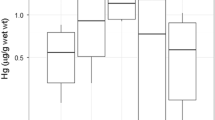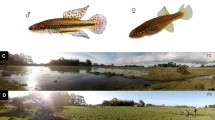Abstract
Reproduction is a demanding activity for animals, since they must produce, and in some cases protect and provision, their young. It is often overlooked that demands of reproduction may also be exacerbated by exposure to contaminants. In this study, we make use of an exceptional long-term dataset to perform a cross-sectional study on the long-lived wandering albatross (Diomedea exulans) in order to test the effects of reproduction, persistent organic pollutants [POPs: pesticides and polychlorinated biphenyls (PCBs)], mercury, individual age (3–47 years), and sex on the levels of plasma oxidative damage and inflammation. The results of our study support the hypothesis that oxidative damage may be a physiological cost of reproduction and that individuals carrying higher levels of organic or non-organic contaminants have higher oxidative damage. Levels of the inflammatory protein haptoglobin were similar between breeding and non-breeding birds, with the exception of breeding males which had the lowest levels of haptoglobin. Our data also show an effect of age and of organic contaminants on the plasma oxidative damage level, but not on plasma haptoglobin. In addition, plasma oxidative damage level increased with red blood cell mercury concentration in females but not in males. Hence, our study highlights that the harmful effects of contaminants may come through interaction with factors like life stage or gender, suggesting potential for high variation in susceptibility to contamination among individuals.





Similar content being viewed by others
References
Alonso-Alvarez C, Bertrand S, Devevey G, Prost J, Faivre B, Sorci G (2004) Increased susceptibility to oxidative stress as a proximate cost of reproduction. Ecol Lett 7:363–368
Alonso-Alvarez C, Bertrand S, Faivre B, Chastel O, Sorci G (2007) Testosterone and oxidative stress: the oxidation handicap hypothesis. Proc R Soc Lond B 274:819–825
Ballatori N, Clarkson TW (1985) Biliary secretion of glutathione and glutathione–metal complexes. Fundam Appl Toxicol 5:816–831
Blévin P, Carravieri A, Jaeger A, Chastel O, Bustamante P, Cherel Y (2013) Wide range of mercury contamination in chicks of southern ocean seabirds. PLoS ONE 8:e54508
Bourgeon S, Leat EH, Magnusdóttir E, Fisk AT, Furness RW, Strøm H, Hanssen SA, Petersen A, Olafsdóttir K, Borgå K, Gabrielsen GW, Bustnes JO (2012) Individual variation in biomarkers of health: influence of persistent organic pollutants in Great skuas Stercorarius skua breeding at different geographical locations. Environ Res 118:31–39
Burger J, Gochfeld M (2004) Marine birds as sentinels of environmental pollution. EcoHealth 1:263–274
Bustamante P, Lahaye V, Durnez C, Churlaud C, Caurant F (2006) Total and organic Hg concentrations in cephalopods from the North East Atlantic waters: influence of geographical origin and feeding ecology. Sci Tot Environ 368:585–596
Bustnes JO, Erikstad KE, Skaare JU, Bakken V, Mehlum F (2003) Ecological effects of organochlorine pollutants in the Arctic: a study of the glaucous gull. Ecol Appl 13:504–515
Bustnes JO, Moe B, Hanssen SA, Herzke D, Fenstad AF, Nordstad T, Borgå K, Gabrielsen GW (2012) Temporal dynamics of circulating persistent organic pollutants in a fasting seabird under different environmental conditions. Environ Sci Technol 46:10287–10294
Carere C, Costantini D, Sorace A, Santucci D, Alleva E (2010) Bird populations as sentinels of endocrine disrupting chemicals. Ann Ist Super Sanità 46:81–88
Casagrande S, Costantini D, Dell’Omo G, Tagliavini J, Groothuis TGG (2012) Differential effects of testosterone metabolites oestradiol and dihydrotestosterone on oxidative stress and carotenoid-dependent colour expression in a bird. Behav Ecol Sociobiol 66:1319–1331
Costantini D (2008) Oxidative stress in ecology and evolution: lessons from avian studies. Ecol Lett 11:1238–1251
Costantini D, Marasco V, Møller AP (2011) A meta-analysis of glucocorticoids as modulators of oxidative stress in vertebrates. J Comp Physiol B 181:447–456
Dell’Omo G (2002) Behavioural ecotoxicology. Wiley, New York
Erikstad KE, Sandvik H, Reiertsen TK, Bustnes JO, Strøm H (2013) Persistent organic pollution in a high-Arctic top predator: sex-dependent thresholds in adult survival. Proc R Soc Lond B 280:20131483
Frederick P, Jayasena N (2011) Altered pairing behaviour and reproductive success in white ibises exposed to environmentally relevant concentrations of methylmercury. Proc R Soc Lond B 278:1851–1857
Fridolfsson AK, Ellegren H (1999) A simple and universal method for molecular sexing of non-ratite birds. J Avian Biol 30:116–121
Froy H, Phillips RA, Wood AG, Nussey DH, Lewis S (2013) Age-related variation in reproductive traits in the wandering albatross: evidence for terminal improvement following senescence. Ecol Lett 16:642–649
Garratt M, Pichaud N, King EDA, Brooks RC (2013) Physiological adaptations to reproduction I experimentally increasing litter size enhances aspects of antioxidant defence but does not cause oxidative damage in mice. J Exp Biol 216:2879–2888
Goutte A, Bustamante P, Barbraud C, Delord K, Weimerskirch H, Chastel O (2014) Demographic responses to mercury exposure in two closely-related Antarctic top predators. Ecology 95:1075–1086
Halliwell BH, Gutteridge JMC (2007) Free radicals in biology and medicine, 4th edn. Oxford University Press, Oxford
Hegseth MN, Camus L, Gorbi S, Regoli F, Gabrielsen GW (2011) Effects of exposure to halogenated organic compounds combined with dietary restrictions on the antioxidant defense system in herring gull chicks. Sci Tot Environ 409:2717–2724
Hindell MA, Brothers N, Gales R (1999) Mercury and cadmium concentrations in the tissues of three species of southern albatrosses. Polar Biol 22:102–108
Hoffman DJ, Heinz GH (1998) Effects of mercury and selenium on glutathione metabolism and oxidative stress in mallard ducks. Environ Toxicol Chem 17:161–166
Houde M, Pacepavicius G, Wells RS, Fair PA, Letcher RJ, Alaee M, Bossart GD, Hohn AA, Sweeney J, Solomon KR, Muir DC (2006) Polychlorinated biphenyls and hydroxylated polychlorinated biphenyls in plasma of bottlenose dolphins Tursiops truncatus from the Western Atlantic and the Gulf of Mexico. Environ Sci Technol 40:5860–5866
Isaksson C (2010) Pollution and its impact on wild animals: a meta-analysis on oxidative stress. EcoHealth 7:342–350
Jelena A, Mirjana M, Desanka B, Svetlana IM, Aleksandra U, Goran P, Ilijana G (2013) Haptoglobin and the inflammatory and oxidative status in experimental diabetic rats: antioxidant role of haptoglobin. J Physiol Biochem 69:45–58
Jones DP (2006) Redefining oxidative stress. Antioxid Redox Signal 8:1865–1879
Kahle S, Becker PH (1999) Bird blood as bioindicator for mercury in the environment. Chemosphere 39:2451–2457
Ketterson ED, Nolan VJ (1992) Hormones and life histories: an integrative approach. Am Nat 140:S33–S62
Koivula MJ, Eeva T (2010) Metal-related oxidative stress in birds. Environ Pollut 158:2359–2370
Körmöczi GF, Säemann MD, Buchta C, Peck-Radosavljevic M, Mayr WR, Schwartz DW, Dunkler D, Spitzauer S, Panzer S (2006) Influence of clinical factors on the haemolysis marker haptoglobin. Eur J Clin Invest 36:202–209
Lecomte VJ, Sorci G, Cornet S, Jaeger A, Faivre B, Arnoux E, Gaillard M, Trouvé C, Besson D, Chastel O, Weimerskirch H (2010) Patterns of aging in the long-lived wandering albatross. Proc Natl Acad Sci USA 107:6370–6375
Losdat S, Helfenstein F, Gaude B, Richner H (2011) Reproductive effort transiently reduces antioxidant capacity in a wild bird. Behav Ecol 22:1218–1226
Matson KD, Horrocks NP, Versteegh MA, Tieleman BI (2012) Baseline haptoglobin concentrations are repeatable and predictive of certain aspects of a subsequent experimentally-induced inflammatory response. Comp Biochem Physiol Part A 162:7–15
Metcalfe NB, Alonso-Alvarez C (2010) Oxidative stress as a life-history constraint: the role of reactive oxygen species in shaping phenotypes from conception to death. Funct Ecol 24:984–996
Metcalfe NB, Monaghan P (2013) Does reproduction cause oxidative stress? An open question. Trends Ecol Evol 28:347–350
Metodiewa D, Dunford HB (1990) The role of myeloperoxidase in the oxidation of biologically active polyhydroxyphenols substituted catechols. Eur J Biochem 193:445–448
Monteiro LR, Furness RW (1995) Seabirds as monitors of mercury in the marine environment. Water Air Soil Pollut 80:851–870
Nigro M, Leonzio C (1996) Intracellular storage of mercury and selenium in different marine vertebrates. Mar Ecol Prog Ser 135:137–143
Nordstad T, Moe B, Bustnes JO, Bech C, Chastel O, Goutte A, Sagerup K, Trouvé C, Herzke D, Gabrielsen GW (2012) Relationships between POPs and baseline corticosterone levels in black-legged kittiwakes (Rissa tridactyla) across their breeding cycle. Environ Pollut 164:219–226
Robinson SA, Lajeunesse MJ, Forbes MR (2012) Sex differences in mercury contamination of birds: testing multiple hypotheses with meta-analysis. Environ Sci Technol 46:7094–7101
Scheuhammer AM, Meyer MW, Sandheinrich MB, Murray MW (2007) Effects of environmental methylmercury on the health of wild birds mammals and fish. Ambio 36:12–19
Sorci G, Faivre B (2009) Inflammation and oxidative stress in vertebrate host–parasite systems. Philos Trans R Soc Lond B 364:71–83
Stearns SC (1992) The evolution of life histories. Oxford University Press, Oxford
Tan SW, Meiller JC, Mahaffey KR (2009) The endocrine effects of mercury in humans and wildlife. Crit Rev Toxicol 39:228–269
Tapie N, Le Menach K, Pasquaud S, Elie P, Devier MH, Budzinski H (2011) PBDE and PCB contamination of eels from the Gironde estuary: from glass eels to silver eels. Chemosphere 83:175–185
Tartu S, Goutte A, Bustamante P, Angelier F, Moe B, Clément-Chastel C, Bech C, Gabrielsen GW, Bustnes JO, Chastel O (2013) To breed or not to breed: endocrine response to mercury contamination by an Arctic seabird. Biol Lett 9:20130317
Tavares S, Xavier JC, Phillips RA, Pereira ME, Pardal MA (2013) Influence of age sex and breeding status on mercury accumulation patterns in the wandering albatross Diomedea exulans. Environ Pollut 181:315–320
Thompson DR, Furness RW (1989) The chemical form of mercury stored in south Atlantic seabirds. Environ Pollut 60:305–317
Travers M, Clinchy M, Zanette L, Boonstra R, Williams TD (2010) Indirect predator effects on clutch size and the cost of egg production. Ecol Lett 13:980–988
Verboven N, Verreault J, Letcher RJ, Gabrielsen GW, Evans NP (2010) Adrenocortical function of Arctic-breeding glaucous gulls in relation to persistent organic pollutants. Gen Comp Endocrinol 166:25–32
Weimerskirch H, Salamolard M, Sarrazin F, Jouventin P (1993) Foraging strategy of wandering albatrosses through the breeding season: a study using satellite telemetry. Auk 110:325–342
Weimerskirch H, Brothers N, Jouventin P (1997) Population dynamics of wandering albatross Diomedea exulans and Amsterdam albatross D. amsterdamensis in the Indian Ocean and their relationships with long-line fisheries: conservation implications. Biol Conserv 79:257–270
Whysner J, Wang CX (2001) Hepatocellular iron accumulation and increased cell proliferation in polychlorinated biphenyl-exposed Sprague-Dawley rats and the development of hepatocarcinogenesis. Toxicol Sci 62:36–45
Wiersma P, Selman C, Speakman JR, Verhulst S (2004) Birds sacrifice oxidative protection for reproduction. Biol Lett 271:360–363
Acknowledgments
We thank the editor and two anonymous reviewers for providing valuable comments that helped us to improve presentation and interpretation of results. This project was supported by Agence Nationale de la Recherche (ANR PolarTop, O. Chastel) and the French Polar Institute (IPEV, program 109, H. Weimerskirch), Terres Australes et Antarctiques Françaises, Zone Atelier de Recherches sur l’Environnement Antarctique et Subantarctique (CNRS-INEE). B. Faivre and G. Sorci received financial support from the Agence Nationale de la Recherche (ANR STRESS OX and AGE). Field procedures and blood sampling were authorized by the Ethics Committee of IPEV and by the Comité de l’Environnement Polaire. A. Carravieri was supported by a PhD grant from the Poitou–Charentes Region. The authors thank A. Jaeger, H. Maheo, and M. Berlincourt for their assistance in the field; A. Goutte for providing valuable comments on an earlier draft; all the wintering fieldworkers involved in the long-term monitoring programs for their help on the field; and D. Besson, K. Delord and S. Tartu for great help in the POP analysis and for managing the long-term database. This study has been carried out in the framework of the Cluster of Excellence COTE (ANR-10-LABX-45). The Aquitaine Region and the European Union (CPER A2E project) are acknowledged for their financial support. Europe is moving in Aquitaine with the European Regional Development Fund (FEDER).
Author information
Authors and Affiliations
Corresponding author
Additional information
Communicated by Indrikis Krams.
Rights and permissions
About this article
Cite this article
Costantini, D., Meillère, A., Carravieri, A. et al. Oxidative stress in relation to reproduction, contaminants, gender and age in a long-lived seabird. Oecologia 175, 1107–1116 (2014). https://doi.org/10.1007/s00442-014-2975-x
Received:
Accepted:
Published:
Issue Date:
DOI: https://doi.org/10.1007/s00442-014-2975-x




